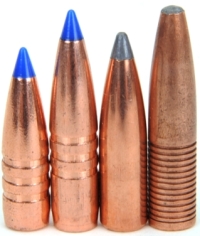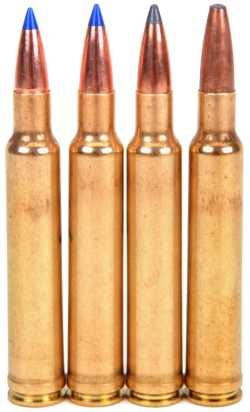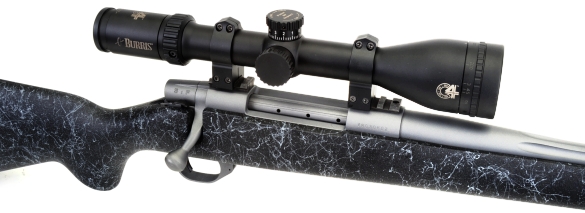
After concluding Part 1, a Burris 4.5-14X42mm C4 scope was installed on the subject rifle. Hmm… that reads like Dragnet dialogue. “The subject was then read his rights and taken to the precinct…” Where was I? Oh, yeah…
Weatherby factory loads, 130 grain and 200 grain, are rated at 3,600+ fps and 3,000+ respectively, when fired from a 26″ barrel rifle. I’d hazard a guess that Roy Weatherby had other things in mind for the 300 Weatherby Magnum than New England tree stands and 50 yard shots at foraging deer.
The 300 Weatherby is a full length magnum, the same length as its 375 H&H parent. The Vanguard Series 2 Back Country accommodates a cartridge approximately 0.060″ longer than maximum SAAMI cartridge overall length, as determined by the interior dimensions of the rifle’s magazine box. Bolt stroke is approximately 1/2″ longer than maximum and barrel’s freebore is 0.361″.
The Back Country can reliably cycle maximum length 300 Weatherby Magnum cartridges. As verified with an overall length gauge, the freebore can safely accommodate any bullet ogive design without leade contact well beyond any functional COL. This means greater latitude in bullet selection for the handloader, without the degree of bullet shank incursion associated with the 300 WSM and 300 Winchester Magnums.

| Bullet Brand | Construction | # | Weight | Length |
| Barnes TTSX | Solid Copper | 30873 | 130 | 1.175 |
| Barnes TTSX | Solid Copper | 30878 | 168 | 1.416 |
| Nosler Partition | Lead Core H Frame | 16331 | 180 | 1.261 |
| North Fork SS | Solid Shank – Lead Core | .308-200 | 200 | 1.421 |
The lightweight selection is the Barnes 130 grain TTSX. Unlike virtually every other bullet of a similar weight, this bullet is intended for antelope, deer and sheep hunting rather than for varmint hunting. It will hold up at high velocity, near or far, and expand properly.
Our middleweight selection is the Barnes 168 grain TTSX. It sports a different ogive and improved B.C. in comparison to their 165 grain TTSX. The 165 grain has a shorter tangent ogive to work within the confines of the 300 WSM and 300 Winchester Magnum COL.
The light heavyweight selection is the Nosler Partition 180 grain. It is a relatively short lead core bullet that will tell me if I left too much velocity on the table by going with the solid copper bullets with greater bore friction and slightly diminished net case capacity. The H jackets are tough and at least the shank always stays together even if the nose gets blown away. I could have selected the Swift A Frame, but the Nosler has better B.C.
 The heavyweight selection is the North Fork 200 grain SS (Semi Spitzer). It is a bit of a hybrid with a solid copper shank and a jacketed lead core nose. I think they are the toughest bullet on the list with deep penetration, controlled expansion and very high weight retention. The other thing they do well is track straight through soft tissue.
The heavyweight selection is the North Fork 200 grain SS (Semi Spitzer). It is a bit of a hybrid with a solid copper shank and a jacketed lead core nose. I think they are the toughest bullet on the list with deep penetration, controlled expansion and very high weight retention. The other thing they do well is track straight through soft tissue.
A while back we did extensive testing of bullet path in ballistic medium with .308″, .375″ and .458″ bullets of this type, as well as solids made for dangerous game hunting and deep penetration. It was amazing how many solids exited an 8″ diameter tube after less than 6″ – 8″ of penetration. This particular bullet, and only a couple of others, tracked ran right down the center and expanded well before coming to a stop. That says a lot about the appropriateness of the bullet’s form.
The handloading process was uneventful. Once fired, full length resized Weatherby (Norma) brass was used when recording velocity or shooting for accuracy. Barnes recommends crimping the 135 grain because of its short shank. I did not crimp any of these for this process, however, I would have crimped them all if they were going hunting. Loads listed are not light. Half a grain on the AA MagPro and RS Magnum is the difference between normal and a tattooed case head.
| |
Warning: Bullet selections are specific, and loads are not valid with substitutions of different bullets of the same weight. Variations in bullet length will alter net case capacity, pressure and velocity. Primer selection is specific and primer types are not interchangeable. These are maximum loads in my firearms and may easily be excessive in others. All loads should be reduced by 2%, and developed following safe handloading practices as represented in established reloading manuals produced by component manufacturers. Presentation of these loads does not constitute a solicitation for their use, nor a recommendation.
|
||||||||||||||||||||||||||||||||||||||||||||||||||||||||||||||||||||||||||||||||||||||||||||||||||||||||||||||||||||||||||||||||||||||||||||||||||||||
|
|||||||||||||||||||||||||||||||||||||||||||||||||||||||||||||||||||||||||||||||||||||||||||||||||||||||||||||||||||||||||||||||||||||||||||||||||||||||
Performance and conclusions…
With the exception of the 168 grain load, the lightweight Vanguard Series 2 Back Country with 24″ barrel, came within 100 – 125 fps of the 26″ barrel Weatherby factory ammo specs, a difference that is barely noticeable on a trajectory curve. As for the Vanguard Series 2 Back Country’s upside, it weights a full 2 pounds less than an Accumark Mark V and it’s price tag is $700 smaller.

Personally, this is my favorite Vanguard. The new stock and the Cerakote finish look really good and they both add a good deal of durability to the rifle and make it useful in harsh environments. The 300 Weatherby Magnum is… stout. It is a lot of bark in a lightweight rifle, but the Weatherby stock geometry does a lot to minimize felt recoil and some of the lighter bullet loads, like the 130 grain, recoil more like a 30-06 Springfield with 165 or 180 grain bullets. Long range shooting is part of this firearm’s nature as is close-in bear hunting. It is a lot of gun.
Weatherby’s Vanguard Series 2 Back Country Part 1
Weatherby’s Vanguard Series 2 Back Country Part 2

Email Notification